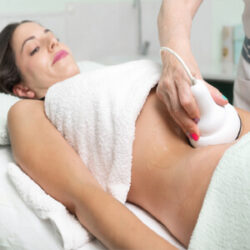What Causes Stretch Marks?
Several factors have been linked to the formation of stretch marks:
Puberty: Stretch marks may occur on the back, breasts or abdominal area during the growth spurt of puberty.
Fluctuations in fat or muscle: Obesity and rapid weight loss are among the most common causes of stretch marks. Weightlifters are also prone to developing stretch marks due to muscle gain.
Pregnancy: Stretch marks frequently develop during the third trimester of pregnancy, likely as a result of the weight gain and hormonal changes associated with pregnancy.
Medications: Inappropriate use of corticosteroid creams, ointments or tablets may cause stretch marks.
Diseases: Some medical disorders, including Cushing’s syndrome, Marfan syndrome or Ehlers-Danlos syndrome, can predispose an individual to developing stretch marks.
What Do Stretch Marks Look Like?
Stretch marks are fine lines that run through the skin. There are two types of stretch marks. New stretch marks are called striae rubra. They can be red, pink or purple depending on your skin tone, and may be slightly raised or itchy. Old stretch marks are called striae alba. As stretch marks age, they flatten and lighten. Striae alba are white or silvery in colour and may become wrinkled or papery in feel.
What Can I Do at Home for My Stretch Marks?
Home remedies such as cocoa butter, almond oil and vitamin E are often recommended for treating stretch marks. However, in studies, these popular DIY methods have proven ineffective. Research into many of the specialised creams, lotions and gels sold to reduce stretch marks has also found that these products are limited in their benefits. Some do not seem to have any effect on stretch marks. Others may have a positive impact, but there is no single product that helps every patient.
If you would like to try one of these products, be sure to:
Check with your doctor if you are pregnant or breastfeeding, as some products contain ingredients that can be harmful to a baby
Begin using the product as early as possible, when the stretch marks are new
Massage the product into your stretch marks to maximise penetration into your skin
Apply the product daily and continue use for weeks; it may be some time before results appear
When Should I See a Dermatologist to Treat My Stretch Marks?
Mature stretch marks are significantly harder to treat than early-stage stretch marks. Treatment should commence as soon as possible to achieve the maximum reduction in colour, length and width of your stretch marks. Early treatment by a dermatologist can also prevent you from wasting time and money on unproven remedies that do not produce results.
How Are Stretch Marks Treated By a Dermatologist?
Thought it is difficult to completely eliminate stretch marks, dermatologists use the following procedures to make stretch marks less noticeable:
Vascular laser: This is the most effective method of treating early red stretch marks. Most patients will benefit from three to five vascular laser treatments, spaced two to four weeks apart.
Resurfacing lasers. These lasers to blend the skin texture. Options including CO2 laser and 1927nm thulium laser
Prescription vitamin A creams: Topical prescription treatments, such as tretinoin, can be combined with laser treatments to treat stretch marks.
Topical silicone-based gel can help ease stretch marks during pregnancy and breastfeeding.
Nanofractional RF: Treatment with radiofrequency energy stimulates the production of collagen and elastin, helping to blend stretch marks with unaffected areas. Five to eight treatments may be necessary to see improvement.
Skin needling: This form of fractional skin treatment can be performed alone or in combination with nanofractional RF treatment. The result from skin needling is generally less reproducible and less noticeable than Nanofractional RF.
At our clinic, our dermatologists often use a combination of the above treatments to give you the best results. Your treatment will vary depending on the unique characteristics of your skin and the extent of your stretch marks.
What Is the Outlook for Stretch Marks?
Most stretch marks will improve with time. As they mature, stretch marks change colour from a bright red or purple, to a softer pink, to a white or flesh-like tone that is less conspicuous against the surrounding skin. Treating early stretch marks using a combination treatment approach yields the best cosmetic outcome.
















